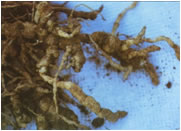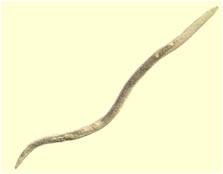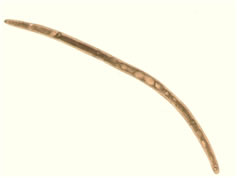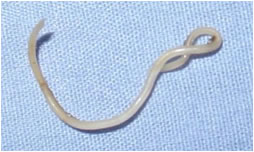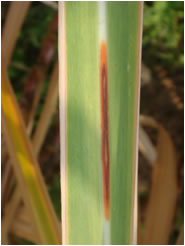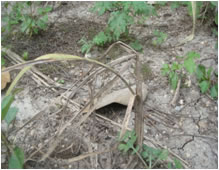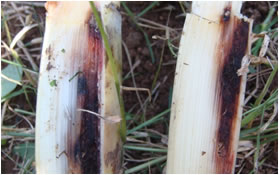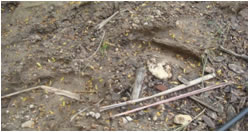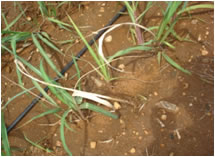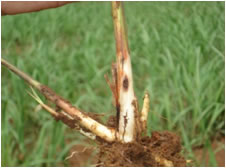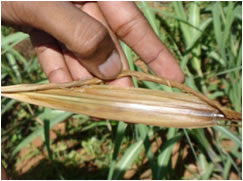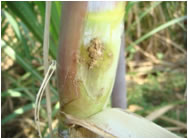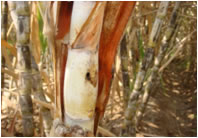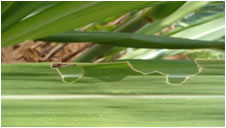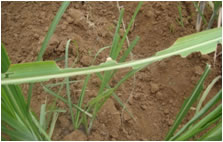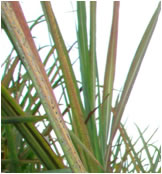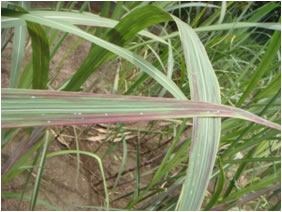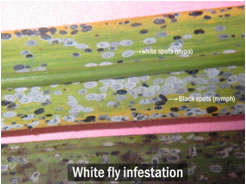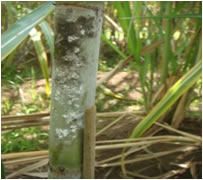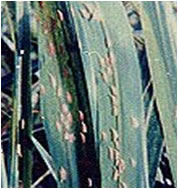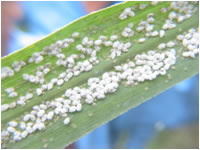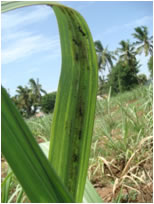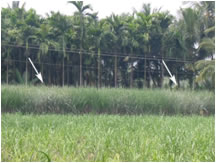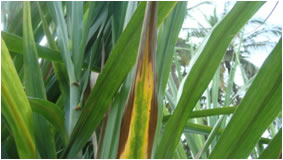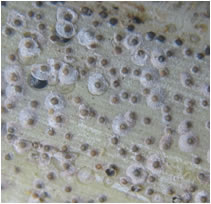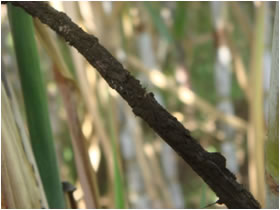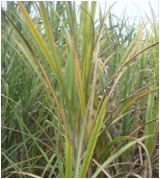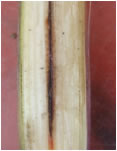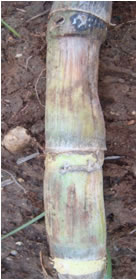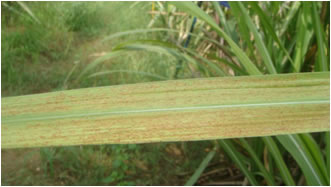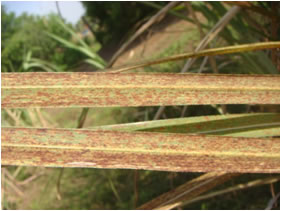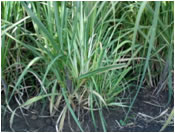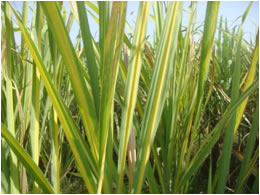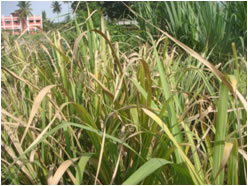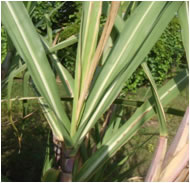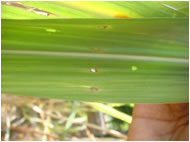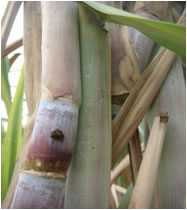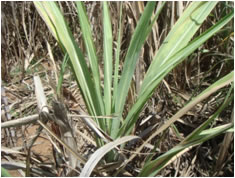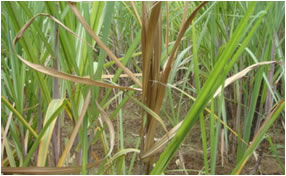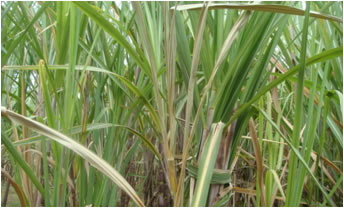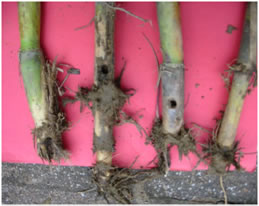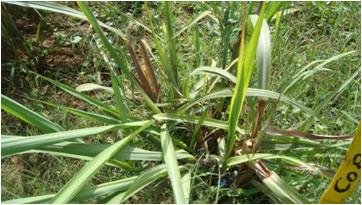
| Germination Phase stage |
| Insect pests | Symptoms |
Advisory |
Image |
| Subterranean Pests 1.Termites: Odontotermes obesus Rhamb |
• Poor germination of setts (after planting).
• Characteristic semi – circular feeding marks on the margin of the leaves in the standing crop.
• Yellowing and drying of outer leaves first, followed by the inner leaves.
• Entire shoot dries up and can be pulled out.
• Setts hollow inside and filled with soil.
• Cane collapses if disturbed.
• Rind filled with mud. |
• Flood irrigation at the time of planting.
• Locate and destroy the termite colony
• Collect and destroy the termite affected setts from the field.
• Fumigate the termite mounds with aluminium phosphide, 2 tablets / 1 meter/Mounds.
• Dip the setts in imidacloprid 70WS 0.1% or chlopyriphos 20 EC 0.04% for 5min.
• Treat the soil with lindane 1.6 D @ 50 kg / ha or
• Apply 125 kg of heptachlor 3 % D per ha in the furrows at time of planting. |
|
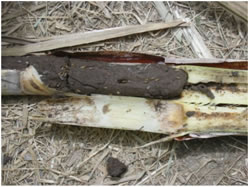 |
| Non insect pests | Symptoms |
Advisory |
Image |
1. Lesion nematode - Pratylenchus coffeae
2. Lance nematode - Hoplolaimus indicus
3. Root knot nematode - Meloidogyne spp.
4. Reniform nematode - Rotylenchulus reniformis. |
• Usually paling of leaves, first in the form of streaks, later complete yellowing-chlorosis, occurring in patches spread out all over the field. Chlorosis in severe cases, accompanied by drying up of margins and leaf tips is more common in ratoon and young crop.
• Stunting of crop, reduction in number and size of internodes.
• Roots are stubby and spares.
• Affected field shows pale green to whitish look. |
Cultural method:
• Deep ploughing, solarisation, flooding, crop rotation and apply organic manure.
• Under wetland conditions, intercropping with sunnhemp or marigold or daincha
• Apply pressmud at 15 t/ha or poultry manure @ 2 t/ha or neem cake 2 t/ha or poultry manure @ 1 t/ha before last ploughing in garden lands.
Biological method:
• Application of biocontrol agents like Pochonia chlamydosporia, Paecilomyces lilacinus or Trichoderma viride or Pseudomonas fluorescence @ 20 kg/ha at the time of planting mixed with moist FYM or cured pressmud and distributed uniformly will help in suppressing the plant parasitic nematode.
Chemical method:
• Apply carbofuran 3G @ 33 kg/ha at the time of planting or 2 months after planting or Cartap 3 kg/ha (1.5 kg a.i./ha) |
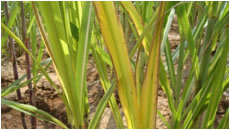 |
1. Lesion nematode - Pratylenchus coffeae
2. Lance nematode - Hoplolaimus indicus
3. Root knot nematode - Meloidogyne spp.
4. Reniform nematode - Rotylenchulus reniformis.
|
| Disease | Symptom of Damage |
Advisory |
Image |
| Red rot: Colletotrichum falcatum | • Leaf colour changes from green to orange and then to yellow in the third or fourth leaf.
• Leaves start drying from bottom to top.
• Cane loses its normal colour and longitudinal discoloration spots / ribs.
• Shrinking of Internode with rupture of tissue in the root eye region.
• Reddish spots on the backside of the leaf midrib.
• The external symptoms appear only after 16 - 21 days after infection and drying of entire cane takes another 10 days time.
• When the affected cane is split opened, it shows the inner region is reddish in colour with intermittent white tinges across the cane length.
• Ash colour fungal growth is seen inside the cane If the variety is highly susceptible or disease incidence is severe, .
• Sometimes, the pith inside the cane is filled with blackish brown liquid and produces alchohol odour. |
Cultural method
• The red rot affected field must be rotated with rice for one season and other crops for two seasons.
• Growing of recommended resistant and moderately resistant varieties viz., Co 86249, CoSi 95071, CoG 93076, CoC 22, CoSi 6 and CoG 5
Physical method
• Removal of the affected clumps at an early stage and soil drenching with Carbandazim 50 WP (1 gm in 1 litre of water)
Chemical method
• Adopt sett treatment with Carbendazim before planting (Carbendazim 50 WP (0.5 gm in 1 litre of water) or Carbendazim 25 DS (1gm in 1 litre of water) along with Urea (10 gm in 1 litre of water) for 5 minutes) |
|
| Disease | Symptom of Damage |
Advisory |
Image |
| Sett rot: Ceratocytis paradoxa | • Rotting of setts before germination, or the shoots may die after reaching a height of about 6-12 inches.
• As the setts get dried up, the reddish colour becomes black with lots of black coloured fungal spores adhering to it.
• If infected shoots survive, they are very much stunted and chlorotic.
• Eventually the leaves may wither and the shoots wilt.
• If the affected shoots and setts are examined the central portion of the shoots will be seen discoloured red and the contents of the sett rotting.
• When split opened, the affected setts exhibit pineapple odour. |
Cultural method
• Proper drainage and planting of setts at 1-2 cm depth.
Chemical method
• Sett treatment with Carbendazim or bavistin before planting (Bavistin @ 1per cent or Carbendazim 50 WP @0.5 gm in 1 litre of water or Carbendazim 25 DS @ 1gm in 1 litre of water along with Urea @10 gm in 1 litre of water for 5 minutes)
• Pre treatment the setts with hot water stimulates germination of buds and hasten growth so as to help the young plants to overcome the competition with the pathogen. |
|
| Parts affected | Symptoms |
Management |
Image |
| Leaves | •yellow undersized leaves
|
• Application of recommended nitrogenous fertilizers (69kg of Urea/acre) or foliar application of Urea 20gm-40gm/lit water at fortnightly intervals. |  |
| Tillering Phase stage |
| Insect pests | Symptoms |
Advisory |
Image |
| Early shoot borer: Chilo infuscatellus Snellen | • Dead heart in 1-3 month old crop, which can be easily pulled out,
• Rotten portion of the straw coloured dead – heart emites an offensive odour.
• Number of bore holes at the base of the shoot just above the ground level.
• ETL: 15% dead heart. |
Cultural method
• cultivate resistant varities like Co 312, Co 421, Co 661, Co 917 and Co 853.
• Adopt Early planting during December – January to escape the shoot borer incidence.
• Incorporate Daincha to reduces the incidence of early shoot borer.
• Trash mulching along the ridges to a thickness of 10-15 cm 3 days after planting.
•Maintain adequate moisture to bring down the soil temperature and increase humidity (unfavourable condition for the multiplication of early shoots borer).
• Remove and destroy dead hearts.
Biological method
• Apply granulosis virus 1.1 x 10 5 IBS / ml (750 diseased larvae / ha) twice on 35 and 50 DAP
• Release 125 gravid females of sturmiopsis inferens, a tachinid parasite per acre.
Chemical method
• Apply any one of the following insecticides if the pest crosses ETL.
• Carboryl +Lindane (Sevidol) 4% G 12.5 kg, lindane 10 G 12.5 kg, Carbofuron 3G 33 kg (Soil application).
• The granular application should be immediately followed by irrigation.
• spray Chlorpyriphos 1000 ml a sticker like Teepol (250 ml / 500 l of water) can also be added to make the solution stick on to the surface of the crop and use high volume sprayer for effective spray. |
|
|
| Insect pests | Symptoms |
Advisory |
Image |
| Internode Borer: Chilo sacchariphagus indicus (Kapur): | • Constricted and shortened internodes, with a number of boreholes filled with excreta at nodal region.
• Reddening of affected tissues. |
Cultural method
• Use resistant varities like Co 975, CoJ 46 and Co 7304.
• Select internode borer damage free setts for planting.
• Detrashing & burying the trash during the 5th, 7th and 9th month after planting.
Physical method
• Collect and destroy the eggs periodically.
• Detrash the crop on 150th and 210th day of planting. Detrashing dislodge the pupae that remain in the leaf sheath.
Biological method
• Release egg parasite, Trichogramma chilonis at the rate of 2.5 cc / release / ha. Six release at fortnightly intervals starting from 4th month onwards.
• Setting pheromone traps at spindle level on 5th month of the crop at the rate of 6 traps per acre in a 15 metre grid. The pheromone septa need to be changed twice at 75 days interval.
Chemical method
• Avoid the use of excessive nitrogenous fertilizers. |
|
|
| Insect pests | Symptoms |
Advisory |
Image |
| Grasshoppers: Hieroglyphus banyan |
• Adult and nymph grasshoppers feed on leaves from the margins of the leaf blades creating cutout areas during the solitary stage.
• finally it leaves only the leaf midrib. |
Cultural method
• Proper tillage of field which eliminate the plants on which grasshoppers feeds.
Biological method
• Baits containing the protozoan Nosema locustae for treating grasshopper breeding sites. This is sold under the trade names Nolobait or Semaspore and can produce infection of many species of grasshoppers. It is highly selective against grasshoppers.
|
|
| Insect pests | Symptoms |
Advisory |
Image |
| Whiteflies: Aleurolobus barodensis | • Yellowing of leaves
• Leaf turns pinkish or purple and dries gradually
• Infested leaves have white and black dots. |
• Avoid indiscriminate use of insecticides for control of other pests such as pyrilla, black bug, wooly aphids
• Detrashing the puparia bearing leaves and immediately disposing by burning or burying to prevent emergence of adult white flies
• Spray fenitrothion 50 EC @ 2 lit / ha (1000 lit spray fluid) |
|
| Insect pests | Symptoms |
Advisory |
Image |
| Mealybug: Saccharicoccus sacchari | • Pinkish oval insects beneath leaf sheath on the nodes, with whitish mealy coating.
• It also attack roots
• Cane becomes stunted.
• Honey dew secretion leads to development of Sooty mould which gives blackish appearance to canes. |
• Use resistant varieties like CO 439, CO 443, CO 720, CO 730 and CO 7704
• Drain excess water from the field.
• Detrash the crop on 150 and 210 Days After Planting.
• Apply any one of the following insecticides per ha and when the incidence is noticed spray on the stem only, methyl parathion 50 EC 1000 ml, malathion 50 EC 1000 ml. |
|
| Insect pests | Symptoms |
Advisory |
Image |
sugarcane leaf hopper: Pyrilla purpusilla
• Pyrilla is the most destructive foliage-sucking pest of sugarcane
• Heavy rainfall followed by 75-80% humidity, intermittent drought periods, high temperature (26-30°c) and wind movement favour rapid buildup of pyrilla.
• Other factors favouring pyrilla buildup are |
• Adults and the nymps suck leaf sap from the under surface of the lower leaves.
• At heavy infestation leaves turn yellowish white and wither away.
• Top leaves in the affected canes dry up and lateral buds germinate due to continuous desapping by large number of hoppers.
• The hoppers exude a sweet sticky fluid known as honeydew, which promotes quick and luxuriant growth of the fungus, Capanodium species and as a result the leaves are completely covered by the sooty mould. This affects photosynthesis. |
• Collect and destruction of egg masses laid on the lower surface of the leaves.
• Release of egg parasitoid Epiricania melanoleuca cocoons @ 4000 to 5000 or 0.4 to 0.5 million eggs during July-August to check this population or
• Spray Malathion 50 EC or Endosulfan 35 Ec at the rate of 1.25 litre per hectare in 1000 litres of water. |
|
| Insect pests | Symptoms |
Advisory |
Image |
| Sugarcane Wooly Aphid: Ceratovacuna lanigera | • Adults and nymphs suck the sap from leaves.
• Whitish patches – coalesce to turn yellowish and drying from the tip along margins.
• Leaves become brittle and dries up completely.
• Heavy honey dew secretion leads to sooty mould development.
• Wooly matter deposition on ground / soil. |
• Adopt Paired row system of planting.
• Avoid excessive use of nitrogenous fertilizers.
• Use organic fertilizers.
• wrapping of canes all along the rows.
• Infested tops should not be transported.
• Infested canes should not be used as seed for planting.
• Infested canes should not be used as seed for planting.
• Dip the seed sets in Chlorpyripos 20 EC solution (2 ml / lit) before planting.
• Apply phorate 10 G @ 5kg / ac or Spray with acephate75 SP 1g / lit; Chlorpyriphos 20 EC 2 ml / lit; Malathion 50 EC 2 ml / lit; Dimethoate 30 EC 1.7 ml / lit; Oxydemeton methyl 25 EC 1.3 ml / lit.
• Dusting with Malathion 5% dust @ 10 kg / ac. |
|
| Insect pests | Symptoms |
Advisory |
Image |
| Scale Insects: Melanaspis glomerata (Green) | • The leaves of infested canes show signs of tip drying and unhealthy pale green colour and with continued infestation these turn yellow.
• Desapping leads to non-opening of leaves also, which also turn yellow and finally dry up.
• Nodal region is more infested than internodal region.
• Infested crop losses its vigour, canes shrivel, growth is stunted and the internodal length is reduced drastically.
• Ultimately cane dries up. Such canes when slit open appear brownish red |
Cultural method
• Use resistant varieties like Co 439, Co 443, Co 453, Co 671, Co 691 and Co 692.
• Select and plant the scale insect free setts.
• Keep the fields and bunds free from weeds.
• Avoid water stagnation in the field for the longer period.
• Avoid repeated ratoons.
Physical method
• Detrash the crop at 150th and 210th day of planting.
Biological method
• Release Chilocoris nigritus (or) Pharascymnus horni.
Chemical method
• Presoak the setts in 0.1% solution malathion.
• Spray dimethoate 0.06% or 120th and 150th after detrashing. |
|
|
|
| Disease | Symptom of Damage |
Advisory |
Image |
| Red rot: Colletotrichum falcatum | • Leaf colour changes from green to orange and then to yellow in the third or fourth leaf.
• Leaves start drying from bottom to top.
• Cane loses its normal colour and longitudinal discoloration spots / ribs.
• Shrinking of Internode with rupture of tissue in the root eye region.
• Reddish spots on the backside of the leaf midrib.
• The external symptoms appear only after 16 - 21 days after infection and drying of entire cane takes another 10 days time.
• When the affected cane is split opened, it shows the inner region is reddish in colour with intermittent white tinges across the cane length.
• Ash colour fungal growth is seen inside the cane If the variety is highly susceptible or disease incidence is severe, .
• Sometimes, the pith inside the cane is filled with blackish brown liquid and produces alchohol odour. |
Cultural method
• The red rot affected field must be rotated with rice for one season and other crops for two seasons.
• Growing of recommended resistant and moderately resistant varieties viz., Co 86249, CoSi 95071, CoG 93076, CoC 22, CoSi 6 and CoG 5
Physical method
• Removal of the affected clumps at an early stage and soil drenching with Carbandazim 50 WP (1 gm in 1 litre of water)
Chemical method
• Adopt sett treatment with Carbendazim before planting (Carbendazim 50 WP (0.5 gm in 1 litre of water) or Carbendazim 25 DS (1gm in 1 litre of water) along with Urea (10 gm in 1 litre of water) for 5 minutes) |
|
| Disease | Symptom of Damage |
Advisory |
Image |
| Sett rot: Ceratocytis paradoxa | • Rotting of setts before germination, or the shoots may die after reaching a height of about 6-12 inches.
• As the setts get dried up, the reddish colour becomes black with lots of black coloured fungal spores adhering to it.
• If infected shoots survive, they are very much stunted and chlorotic.
• Eventually the leaves may wither and the shoots wilt.
• If the affected shoots and setts are examined the central portion of the shoots will be seen discoloured red and the contents of the sett rotting.
• When split opened, the affected setts exhibit pineapple odour. |
Cultural method
• Proper drainage and planting of setts at 1-2 cm depth.
Chemical method
• Sett treatment with Carbendazim or bavistin before planting (Bavistin @ 1per cent or Carbendazim 50 WP @0.5 gm in 1 litre of water or Carbendazim 25 DS @ 1gm in 1 litre of water along with Urea @10 gm in 1 litre of water for 5 minutes)
• Pre treatment the setts with hot water stimulates germination of buds and hasten growth so as to help the young plants to overcome the competition with the pathogen. |
|
| Disease | Symptom of Damage |
Advisory |
Image |
| Smut: Ustilago scitaminea | • Production of whip like structure of 25 – 150 cm. from the growing point of the canes.
• Whip covered by translucent silvery membrane enclosing mass of black powdery spores.
• Initial thin canes with elongated internodes later become reduced in length.
• Profuse sprouting of lateral buds with narrow, erect leaves especially in ratoon crop. |
Cultural method
• Growing of resistant and moderately resistant varieties viz., Co 86249, CoG 93076, CoC 22, CoSi 6 and CoG 5.
• Discourage ratooning of the diseased crops having more than 10 per cent infection.
• Grow Chick pea, Cajanus cajan as a companion crop between rows of sugarcane, which reduces the secondary spread of the disease.
Physical method
• Treating the seed setts with Areated Steam Therapy (AST) at 50 ºC for 1 hour or in hot water at 50 ºC for 30 minutes or at 52 ºC for 18 minutes.
• Roguing of smut whips in gunny bags/polythene bag and dipped in boiling water for 1 hour.
• Uproot and burn the diseased clumps.
Chemical method
• Sett treatment with fungicides viz., Triadimefon @ 1gm in 1 litre of water or Carbendazim @ 1gm in 1 litre of water for 10 minutes. |
|
| Disease | Symptom of Damage |
Advisory |
Image |
| Wilt: Fusarium sacchari |
External: gradual yellowing and drying of foliage, shrinkage/withering of canes.
Internal: Light to dark purplish or brown discolouration of ground tissue, pithiness and boat shaped cavities in the middle of the internodes. |
Cultural method
• selection of healthy setts.
• Sett treatment with fungicides.
• Cultivating resistant varieties.
• Crop rotation.
• Managing root borer incidence.
• Avoiding prolonged drought and water logging.
• Adopting hygienic intercultural practices.
Chemical Method
• Dipping the setts in 40 ppm of boron or manganese, or spraying the plants reduces the disease intensity. |
|
| Disease | Symptom of Damage |
Advisory |
Image |
Rust: Puccinia erianthi Rust is an air borne disease. The fungi enter into the tissues through the stomata and cause the disease. The fungi are carried away up to 15km. in the coastal sea breeze and affect sugarcane crop. |
• Sugarcane rust is mainly a disease of the leaf.
• The earliest symptoms are small, elongated yellowish spots that are visible on both leaf surfaces.
• The spots increase in length, turn brown to orange brown or red brown in color.
• Pustules, which produce spores, usually develop on the lower leaf surface. |
Cultural method
• Use resistant varieties like Co 91010 (Dhanush), Co 87025 (Kalyani)
Chemical method
• Spray Tridemorph 1.0 litres or Mancozeb 2.0 kg/ha. |
|
| Disease | Symptom of Damage |
Advisory |
Image |
Grassy shoot disease (GSD): MLO
• The disease is caused by Mycoplasma like organisms (MLO).
• If affected setts used planting, germination is affected by 10 – 60%.
• Plant height, cane yield, quality of juice and sugar content are reduced.
Mode of spread
• The disease is spread by the use of affected setts for planting.
• Also, the black hopper (Browtista moesta) acts as a vector for this disease. |
• Initial symptom appears in the young crop of 3 – 4 months age as thin papery white young leaves at the top of the cane.
• Later, white or yellow tillers appear in large number below these leaves (profuse tillering).
• The cane becomes stunted with reduced internodal length.
• There is no millable cane formation.
• One or two canes grow well in the affected tillers with greenish leaves.
• When these seemingly good canes are used for setts, the following crop produces only whitish leaves; these leaves dry early and make gaps in the field. |
• Growing resistant varieties viz., Co 86249, CoG 93076 and CoC 22.
• Avoid ratooning if GSD incidence is more than 15 % in the plant crop.
• Remo infected plants in the secondary and commercial seed nursery.
• Treat setts with aerated steam at 50°C for 1 hour to control primary infection.
• Treating them with hot air at 540C for 8 hours and spraying twice a month with aphidicides.
• Spray dimethoate @ 1ml in 1 litre of water to control insect vector. |
|
| Disease | Symptom of Damage |
Advisory |
Image |
| Yellow Leaf Disease: viral disease, transmitted by aphids, Melanaphis sacchari and Rhopalosiphum maidis. | • Yellowing of midrib and adjacent laminar region and subsequent leaf drying along the mid rib in 3 to 5 leaves from top.
• In some cases reddish discolouration is also seen
• Drying of spindle along with leaves in severe cases. |
• Use healthy seed cane.
• Maintain proper field hygiene.
• Application balanced fertilizers.
• Use resistant varieties.
• Secondary transmission of the disease by insect vectors can be controlled by application of Malathion(0.1%) or Dimecron(0.2%). |
|
| Grand Growth Phase stage |
| Insect pests | Symptoms |
Management |
Advisory |
| Top Borer: Scirpophaa excerptalis (Fb.) | • Dead heart arise on after sixth month grown up canes, which cannot be easily pulled.
• Parallel row of shot holes in the emerging leaves.
• Bore holes at the top of the shoot and shows bunchy top appearance. |
Cultural method
• Use resistant variety Co 419, Co 745 and Co 6516 and tolerant varieties Co 859, Co 1158 and Co 7224.
Physical method
• Collect and destroy the egg masses.
Biological method
• Release Ichneumonid parasitized Gambroides (Isotima) javensis @ 100 pairs / ha as prepupal parasitoid.
Chemical method
• Application of Carbofuran 3G 1 kg a.i/ha or Thimet 10G 3 kg a.i/ha |
|
| Dead heart in grown up cane Parallel row of shoot holes Damages on top of cane Bunchy top appearance | |||
|
| Insect pests | Symptoms |
Management |
Advisory |
| White Grub: Holotrichia consanguinea (Blanch): | • Yellowing and wilting of leaves.
• Drying of entire crown.
• Affected canes come off easily when pulled.
• Cause extensive damage to roots and base of shoot. |
• Provide adequate irrigation
• Deep ploughing immediately after harvesting.
• Set up light trap.
• Collect and destroy the adult beetles.
• Apply lindane 1.6 D @ 50 kg/ha near the root zone. |
|
| Insect pests | Symptoms |
Advisory |
Image |
| Whiteflies: Aleurolobus barodensis | • Yellowing of leaves
• Leaf turns pinkish or purple and dries gradually
• Infested leaves have white and black dots. |
• Avoid indiscriminate use of insecticides for control of other pests such as pyrilla, black bug, wooly aphids
• Detrashing the puparia bearing leaves and immediately disposing by burning or burying to prevent emergence of adult white flies
• Spray fenitrothion 50 EC @ 2 lit / ha (1000 lit spray fluid) |
|
| Insect pests | Symptoms |
Advisory |
Image |
| Mealybug: Saccharicoccus sacchari | • Pinkish oval insects beneath leaf sheath on the nodes, with whitish mealy coating.
• It also attack roots
• Cane becomes stunted.
• Honey dew secretion leads to development of Sooty mould which gives blackish appearance to canes. |
• Use resistant varieties like CO 439, CO 443, CO 720, CO 730 and CO 7704
• Drain excess water from the field.
• Detrash the crop on 150 and 210 Days After Planting.
• Apply any one of the following insecticides per ha and when the incidence is noticed spray on the stem only, methyl parathion 50 EC 1000 ml, malathion 50 EC 1000 ml. |
|
| Insect pests | Symptoms |
Advisory |
Image |
sugarcane leaf hopper: Pyrilla purpusilla
• Pyrilla is the most destructive foliage-sucking pest of sugarcane
• Heavy rainfall followed by 75-80% humidity, intermittent drought periods, high temperature (26-30°c) and wind movement favour rapid buildup of pyrilla.
• Other factors favouring pyrilla buildup are |
• Adults and the nymps suck leaf sap from the under surface of the lower leaves.
• At heavy infestation leaves turn yellowish white and wither away.
• Top leaves in the affected canes dry up and lateral buds germinate due to continuous desapping by large number of hoppers.
• The hoppers exude a sweet sticky fluid known as honeydew, which promotes quick and luxuriant growth of the fungus, Capanodium species and as a result the leaves are completely covered by the sooty mould. This affects photosynthesis. |
• Collect and destruction of egg masses laid on the lower surface of the leaves.
• Release of egg parasitoid Epiricania melanoleuca cocoons @ 4000 to 5000 or 0.4 to 0.5 million eggs during July-August to check this population or
• Spray Malathion 50 EC or Endosulfan 35 Ec at the rate of 1.25 litre per hectare in 1000 litres of water. |
|
| Insect pests | Symptoms |
Advisory |
Image |
| Sugarcane Wooly Aphid: Ceratovacuna lanigera | • Adults and nymphs suck the sap from leaves.
• Whitish patches – coalesce to turn yellowish and drying from the tip along margins.
• Leaves become brittle and dries up completely.
• Heavy honey dew secretion leads to sooty mould development.
• Wooly matter deposition on ground / soil. |
• Adopt Paired row system of planting.
• Avoid excessive use of nitrogenous fertilizers.
• Use organic fertilizers.
• wrapping of canes all along the rows.
• Infested tops should not be transported.
• Infested canes should not be used as seed for planting.
• Infested canes should not be used as seed for planting.
• Dip the seed sets in Chlorpyripos 20 EC solution (2 ml / lit) before planting.
• Apply phorate 10 G @ 5kg / ac or Spray with acephate75 SP 1g / lit; Chlorpyriphos 20 EC 2 ml / lit; Malathion 50 EC 2 ml / lit; Dimethoate 30 EC 1.7 ml / lit; Oxydemeton methyl 25 EC 1.3 ml / lit.
• Dusting with Malathion 5% dust @ 10 kg / ac. |
|
| Insect pests | Symptoms |
Advisory |
Image |
| Scale Insects: Melanaspis glomerata (Green) | • The leaves of infested canes show signs of tip drying and unhealthy pale green colour and with continued infestation these turn yellow.
• Desapping leads to non-opening of leaves also, which also turn yellow and finally dry up.
• Nodal region is more infested than internodal region.
• Infested crop losses its vigour, canes shrivel, growth is stunted and the internodal length is reduced drastically.
• Ultimately cane dries up. Such canes when slit open appear brownish red |
Cultural method
• Use resistant varieties like Co 439, Co 443, Co 453, Co 671, Co 691 and Co 692.
• Select and plant the scale insect free setts.
• Keep the fields and bunds free from weeds.
• Avoid water stagnation in the field for the longer period.
• Avoid repeated ratoons.
Physical method
• Detrash the crop at 150th and 210th day of planting.
Biological method
• Release Chilocoris nigritus (or) Pharascymnus horni.
Chemical method
• Presoak the setts in 0.1% solution malathion.
• Spray dimethoate 0.06% or 120th and 150th after detrashing. |
|
| Disease | Symptom of Damage |
Advisory |
Image |
| Red rot: Colletotrichum falcatum | • Leaf colour changes from green to orange and then to yellow in the third or fourth leaf.
• Leaves start drying from bottom to top.
• Cane loses its normal colour and longitudinal discoloration spots / ribs.
• Shrinking of Internode with rupture of tissue in the root eye region.
• Reddish spots on the backside of the leaf midrib.
• The external symptoms appear only after 16 - 21 days after infection and drying of entire cane takes another 10 days time.
• When the affected cane is split opened, it shows the inner region is reddish in colour with intermittent white tinges across the cane length.
• Ash colour fungal growth is seen inside the cane If the variety is highly susceptible or disease incidence is severe, .
• Sometimes, the pith inside the cane is filled with blackish brown liquid and produces alchohol odour. |
Cultural method
• The red rot affected field must be rotated with rice for one season and other crops for two seasons.
• Growing of recommended resistant and moderately resistant varieties viz., Co 86249, CoSi 95071, CoG 93076, CoC 22, CoSi 6 and CoG 5
Physical method
• Removal of the affected clumps at an early stage and soil drenching with Carbandazim 50 WP (1 gm in 1 litre of water)
Chemical method
• Adopt sett treatment with Carbendazim before planting (Carbendazim 50 WP (0.5 gm in 1 litre of water) or Carbendazim 25 DS (1gm in 1 litre of water) along with Urea (10 gm in 1 litre of water) for 5 minutes) |
|
| Disease | Symptom of Damage |
Advisory |
Image |
| Sett rot: Ceratocytis paradoxa | • Rotting of setts before germination, or the shoots may die after reaching a height of about 6-12 inches.
• As the setts get dried up, the reddish colour becomes black with lots of black coloured fungal spores adhering to it.
• If infected shoots survive, they are very much stunted and chlorotic.
• Eventually the leaves may wither and the shoots wilt.
• If the affected shoots and setts are examined the central portion of the shoots will be seen discoloured red and the contents of the sett rotting.
• When split opened, the affected setts exhibit pineapple odour. |
Cultural method
• Proper drainage and planting of setts at 1-2 cm depth.
Chemical method
• Sett treatment with Carbendazim or bavistin before planting (Bavistin @ 1per cent or Carbendazim 50 WP @0.5 gm in 1 litre of water or Carbendazim 25 DS @ 1gm in 1 litre of water along with Urea @10 gm in 1 litre of water for 5 minutes)
• Pre treatment the setts with hot water stimulates germination of buds and hasten growth so as to help the young plants to overcome the competition with the pathogen. |
|
| Disease | Symptom of Damage |
Advisory |
Image |
| Smut: Ustilago scitaminea | • Production of whip like structure of 25 – 150 cm. from the growing point of the canes.
• Whip covered by translucent silvery membrane enclosing mass of black powdery spores.
• Initial thin canes with elongated internodes later become reduced in length.
• Profuse sprouting of lateral buds with narrow, erect leaves especially in ratoon crop. |
Cultural method
• Growing of resistant and moderately resistant varieties viz., Co 86249, CoG 93076, CoC 22, CoSi 6 and CoG 5.
• Discourage ratooning of the diseased crops having more than 10 per cent infection.
• Grow Chick pea, Cajanus cajan as a companion crop between rows of sugarcane, which reduces the secondary spread of the disease.
Physical method
• Treating the seed setts with Areated Steam Therapy (AST) at 50 ºC for 1 hour or in hot water at 50 ºC for 30 minutes or at 52 ºC for 18 minutes.
• Roguing of smut whips in gunny bags/polythene bag and dipped in boiling water for 1 hour.
• Uproot and burn the diseased clumps.
Chemical method
• Sett treatment with fungicides viz., Triadimefon @ 1gm in 1 litre of water or Carbendazim @ 1gm in 1 litre of water for 10 minutes. |
|
| Disease | Symptom of Damage |
Advisory |
Image |
| Wilt: Fusarium sacchari |
External: gradual yellowing and drying of foliage, shrinkage/withering of canes.
Internal: Light to dark purplish or brown discolouration of ground tissue, pithiness and boat shaped cavities in the middle of the internodes. |
Cultural method
• selection of healthy setts.
• Sett treatment with fungicides.
• Cultivating resistant varieties.
• Crop rotation.
• Managing root borer incidence.
• Avoiding prolonged drought and water logging.
• Adopting hygienic intercultural practices.
Chemical Method
• Dipping the setts in 40 ppm of boron or manganese, or spraying the plants reduces the disease intensity. |
|
| Disease | Symptom of Damage |
Advisory |
Image |
Rust: Puccinia erianthi Rust is an air borne disease. The fungi enter into the tissues through the stomata and cause the disease. The fungi are carried away up to 15km. in the coastal sea breeze and affect sugarcane crop. |
• Sugarcane rust is mainly a disease of the leaf.
• The earliest symptoms are small, elongated yellowish spots that are visible on both leaf surfaces.
• The spots increase in length, turn brown to orange brown or red brown in color.
• Pustules, which produce spores, usually develop on the lower leaf surface. |
Cultural method
• Use resistant varieties like Co 91010 (Dhanush), Co 87025 (Kalyani)
Chemical method
• Spray Tridemorph 1.0 litres or Mancozeb 2.0 kg/ha. |
|
| Disease | Symptom of Damage |
Advisory |
Image |
Grassy shoot disease (GSD): MLO
• The disease is caused by Mycoplasma like organisms (MLO).
• If affected setts used planting, germination is affected by 10 – 60%.
• Plant height, cane yield, quality of juice and sugar content are reduced.
Mode of spread
• The disease is spread by the use of affected setts for planting.
• Also, the black hopper (Browtista moesta) acts as a vector for this disease. |
• Initial symptom appears in the young crop of 3 – 4 months age as thin papery white young leaves at the top of the cane.
• Later, white or yellow tillers appear in large number below these leaves (profuse tillering).
• The cane becomes stunted with reduced internodal length.
• There is no millable cane formation.
• One or two canes grow well in the affected tillers with greenish leaves.
• When these seemingly good canes are used for setts, the following crop produces only whitish leaves; these leaves dry early and make gaps in the field. |
• Growing resistant varieties viz., Co 86249, CoG 93076 and CoC 22.
• Avoid ratooning if GSD incidence is more than 15 % in the plant crop.
• Remo infected plants in the secondary and commercial seed nursery.
• Treat setts with aerated steam at 50°C for 1 hour to control primary infection.
• Treating them with hot air at 540C for 8 hours and spraying twice a month with aphidicides.
• Spray dimethoate @ 1ml in 1 litre of water to control insect vector. |
|
| Disease | Symptom of Damage |
Advisory |
Image |
| Yellow Leaf Disease: viral disease, transmitted by aphids, Melanaphis sacchari and Rhopalosiphum maidis. | • Yellowing of midrib and adjacent laminar region and subsequent leaf drying along the mid rib in 3 to 5 leaves from top.
• In some cases reddish discolouration is also seen
• Drying of spindle along with leaves in severe cases. |
• Use healthy seed cane.
• Maintain proper field hygiene.
• Application balanced fertilizers.
• Use resistant varieties.
• Secondary transmission of the disease by insect vectors can be controlled by application of Malathion(0.1%) or Dimecron(0.2%). |
|
rand Growth Phase s
| Maturation and Ripening stage |
| Disease | Symptom of Damage |
Advisory |
Image |
| Smut: Ustilago scitaminea | • Production of whip like structure of 25 – 150 cm. from the growing point of the canes.
• Whip covered by translucent silvery membrane enclosing mass of black powdery spores.
• Initial thin canes with elongated internodes later become reduced in length.
• Profuse sprouting of lateral buds with narrow, erect leaves especially in ratoon crop. |
Cultural method
• Growing of resistant and moderately resistant varieties viz., Co 86249, CoG 93076, CoC 22, CoSi 6 and CoG 5.
• Discourage ratooning of the diseased crops having more than 10 per cent infection.
• Grow Chick pea, Cajanus cajan as a companion crop between rows of sugarcane, which reduces the secondary spread of the disease.
Physical method
• Treating the seed setts with Areated Steam Therapy (AST) at 50 ºC for 1 hour or in hot water at 50 ºC for 30 minutes or at 52 ºC for 18 minutes.
• Roguing of smut whips in gunny bags/polythene bag and dipped in boiling water for 1 hour.
• Uproot and burn the diseased clumps.
Chemical method
• Sett treatment with fungicides viz., Triadimefon @ 1gm in 1 litre of water or Carbendazim @ 1gm in 1 litre of water for 10 minutes. |
|
| Disease | Symptom of Damage |
Advisory |
Image |
| Wilt: Fusarium sacchari |
External: gradual yellowing and drying of foliage, shrinkage/withering of canes.
Internal: Light to dark purplish or brown discolouration of ground tissue, pithiness and boat shaped cavities in the middle of the internodes. |
Cultural method
• selection of healthy setts.
• Sett treatment with fungicides.
• Cultivating resistant varieties.
• Crop rotation.
• Managing root borer incidence.
• Avoiding prolonged drought and water logging.
• Adopting hygienic intercultural practices.
Chemical Method
• Dipping the setts in 40 ppm of boron or manganese, or spraying the plants reduces the disease intensity. |
|
| Disease | Symptom of Damage |
Advisory |
Image |
Grassy shoot disease (GSD): MLO
• The disease is caused by Mycoplasma like organisms (MLO).
• If affected setts used planting, germination is affected by 10 – 60%.
• Plant height, cane yield, quality of juice and sugar content are reduced.
Mode of spread
• The disease is spread by the use of affected setts for planting.
• Also, the black hopper (Browtista moesta) acts as a vector for this disease. |
• Initial symptom appears in the young crop of 3 – 4 months age as thin papery white young leaves at the top of the cane.
• Later, white or yellow tillers appear in large number below these leaves (profuse tillering).
• The cane becomes stunted with reduced internodal length.
• There is no millable cane formation.
• One or two canes grow well in the affected tillers with greenish leaves.
• When these seemingly good canes are used for setts, the following crop produces only whitish leaves; these leaves dry early and make gaps in the field. |
• Growing resistant varieties viz., Co 86249, CoG 93076 and CoC 22.
• Avoid ratooning if GSD incidence is more than 15 % in the plant crop.
• Remo infected plants in the secondary and commercial seed nursery.
• Treat setts with aerated steam at 50°C for 1 hour to control primary infection.
• Treating them with hot air at 540C for 8 hours and spraying twice a month with aphidicides.
• Spray dimethoate @ 1ml in 1 litre of water to control insect vector. |
|
| Disease | Symptom of Damage |
Advisory |
Image |
| Yellow Leaf Disease: viral disease, transmitted by aphids, Melanaphis sacchari and Rhopalosiphum maidis. | • Yellowing of midrib and adjacent laminar region and subsequent leaf drying along the mid rib in 3 to 5 leaves from top.
• In some cases reddish discolouration is also seen
• Drying of spindle along with leaves in severe cases. |
• Use healthy seed cane.
• Maintain proper field hygiene.
• Application balanced fertilizers.
• Use resistant varieties.
• Secondary transmission of the disease by insect vectors can be controlled by application of Malathion(0.1%) or Dimecron(0.2%). |
|
| Disease | Symptom of Damage |
Advisory |
Image |
| Ratoon Stunting: Bacterial disease | • Plants are stunted and stunting is most severe in stubble and ratoon crops.
• Presence of pin head like orange coloured dots of bacteria on the internal soft tissue in the nodal region.
• Setts taken from diseased plants germinate poorly and the few shoots that are emerging grow very slowly.
• It is sap-transmissible and no insect vector has been found. |
• Select healthy setts for planting.
• Treat the setts with hot water at 50°C for about 2 hours. |
|
![]()
Focus Districts
Gallery
